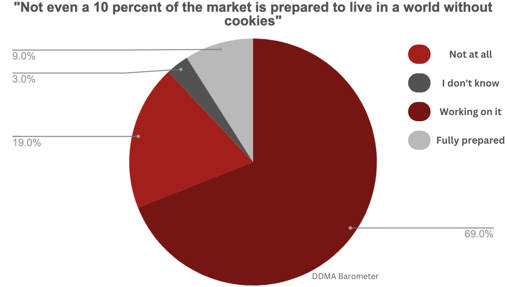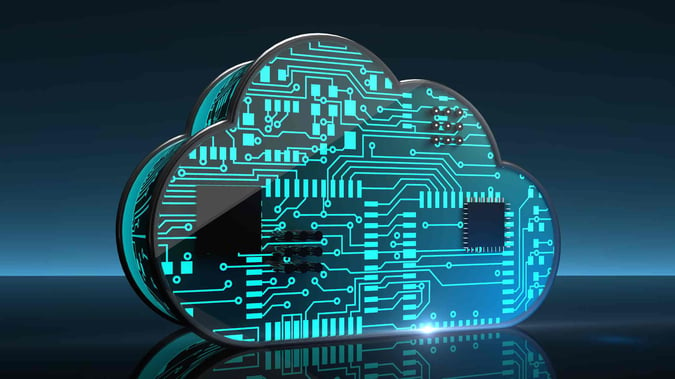Share this
Data Clouds: Why CDP Investment Will Continue to Grow
by Carla Roman on Dec 13, 2022 6:58:17 PM
Along with tech and data experts, we predict that in 2023 Customer Data Platforms (CDP’s) will remain a central influence for B2C and B2B business strategy. Whether for data management, consumer behavior, marketing, or advertisement, success in 2023 will depend on your CDP strength.
As we near the end of 3rd party cookies in 2024, how companies collect, model, activate and orchestrate zero and first-party data will be a key focus area for 2023, keeping CDP’s at the center of any and all data-driven businesses. In fact, according to Deloitte’s 2022 Global Market Trends report, 61% of “high-growth” brands are leveraging CDP’s to either move to a first-party data strategy or to further develop their first-party data capabilities. This trend will continue to rise in 2023.
Additionally, as all businesses pivot to a cookie-less world, investment in CDP technology and data driven skills will continue to increase throughout 2023. Current data estimates that for 2022 CDP revenue increased by 25%.
Considering that current research has found that less than 10% of organizations are prepared for a cookieless era, CDP market revenue for 2023 will follow the same growth trend with a predicted revenue of 2.5 billion.

But What are CDP’s?
If your department has been able to skirt by without needing to pull data from your businesses internal CDP, this will not be the case for 2023. As more businesses compete to provide more personalized marketing experiences, centralizing the multiple touchpoints of your clients journey on a CDP for analysis will be critical.
Also – as explored in our article about public cloud and the CDP revolution – in 2023 more B2C businesses will migrate to Google as they discover that their current CDPs function more as software suites in which third-party applications and native integrations become complicated. Hindering the ability to collect deeper insights on target audiences, campaigns, and consumer conversions, more businesses will opt to move their CDP to the public cloud.
For marketers, a CDP allows you to have the “full-picture” of your buyer as you develop your next digital marketing campaign. With a CDP, you have all the pertinent data of your customer in one place (everything from past purchases, current orders, correspondence, email outreach, etc.) which in turn, gives you an intimate look into a customer’s experience and the factors contributing to their transition from leads to conversions. In a prior blog, Crystalloids explored the range of benefits clients in varying sectors gain from a CDP.
Aside from marketing, departments from customer service to warehouse management will also need to understand how to navigate their internal CDP software. With consumer experience always at the forefront of any business, all departments must now be informed of every customer’s interaction with your business. This will allow for personalized assistance, order tracking, account management, etc.
But Doesn’t it handle the data?
Traditional data workflows will be obsolete in 2023. This means, every department will have to get their hands dirty with data. Where once data silos existed and marketing or sales teams had data that either didn’t speak with one-another or that needed to be pulled by your IT department, a proper CDP now allows all teams to access the same data in real-time.
More critically, as the volume of collected internal data increases with the sunset of third-party cookies, handling and creating meaning from data can no longer be the responsibility of one team. If the capacity to collect and centralize consumer data increases, so should the capacity to access and use the data. This means having a CDP that fully integrates with your current internal martech stack. In other words, if your current CDP software is not integrating with existing CRM and DMP platforms being used, then find a new CDP for 2023.
Also important to note, a CDP doesn’t mean you’ll have to relearn a platform, or that it's replacing the current analytics or BI tools you’ve been using. A CDP is an addition to your current data structure. Instead of accessing analytics from a number of different tools, the same data will now be funneled from one single source. Also, CDPs aren’t designed or intended for only developers, with a broad range of worker personas in mind, the best CDP’s are always user-friendly.
What Type of CDP will Reign in 2023?
As the CDP industry will continue to grow in 2023, so will the variety of options available. Crystalloids has identified the three main architectural approaches our clients weigh when considering a CDP package. You can learn more about these three approaches along with other best practices when building and operating your CDP here.
Industry experts are predicting that throughout 2023 vendors will begin rolling out industry-specific CDP solutions to better accommodate for industry-specific integrations and needs.
But regardless of custom-built or pre-packaged solutions, the major factor for a CDP will be the size of your enterprise and the size and maturity of your current data systems and data literacy in your teams. So as pertaining to CDP data management and infrastructure options in 2023, size will matter.
Where to Begin in 2023?
2023 will be the year of potential data overflow. As businesses start to collect, process and own consumer data, those with ill-equipped data infrastructures will find themselves unable to monetize and leverage this data.
Here is where businesses with a well-structured CDP will gain advantage. In 2023, businesses will need a CDP that connects the various touchpoints of one consumer to create a 360 consumer profile, in order to serve as the central activation point for all digital communication.
Throughout 2023 data-driven businesses and strategy will hinge on proper CDP structure and implementation. We have outlined the most common architectural approaches to CDP’s that our clients have used in the past to better help you understand what structure and packaging could work best for your business.
As always, if you have any questions or unsure how to get started with a CDP solution, feel free to reach out.
ABOUT CRYSTALLOIDS
Crystalloids helps companies improve their customer experiences and build marketing technology. Founded in 2006 in the Netherlands, Crystalloids builds crystal-clear solutions that turn customer data into information and knowledge into wisdom. As a leading Google Cloud Partner, Crystalloids combines experience in software development, data science, and marketing, making them one of a kind IT company. Using the Agile approach, Crystalloids ensures that use cases show immediate value to their clients and make their job focus more on decision making and less on programming.
Share this
- September 2025 (1)
- August 2025 (2)
- July 2025 (1)
- June 2025 (1)
- April 2025 (4)
- February 2025 (2)
- January 2025 (3)
- December 2024 (1)
- November 2024 (5)
- October 2024 (2)
- September 2024 (1)
- August 2024 (1)
- July 2024 (4)
- June 2024 (2)
- May 2024 (1)
- April 2024 (4)
- March 2024 (2)
- February 2024 (2)
- January 2024 (4)
- December 2023 (1)
- November 2023 (4)
- October 2023 (4)
- September 2023 (4)
- June 2023 (2)
- May 2023 (2)
- April 2023 (1)
- March 2023 (1)
- January 2023 (4)
- December 2022 (3)
- November 2022 (5)
- October 2022 (3)
- July 2022 (1)
- May 2022 (2)
- April 2022 (2)
- March 2022 (5)
- February 2022 (2)
- January 2022 (5)
- December 2021 (5)
- November 2021 (4)
- October 2021 (2)
- September 2021 (2)
- August 2021 (3)
- July 2021 (4)
- May 2021 (2)
- April 2021 (2)
- February 2021 (2)
- December 2020 (1)
- October 2020 (2)
- September 2020 (1)
- August 2020 (2)
- July 2020 (2)
- June 2020 (1)
- March 2020 (2)
- February 2020 (1)
- January 2020 (1)
- December 2019 (1)
- November 2019 (3)
- October 2019 (2)
- September 2019 (3)
- August 2019 (2)
- July 2019 (3)
- June 2019 (5)
- May 2019 (2)
- April 2019 (4)
- March 2019 (2)
- February 2019 (2)
- January 2019 (4)
- December 2018 (2)
- November 2018 (1)
- October 2018 (1)
- September 2018 (2)
- August 2018 (3)
- July 2018 (3)
- May 2018 (2)
- April 2018 (4)
- March 2018 (5)
- February 2018 (1)
- January 2018 (3)
- November 2017 (2)
- October 2017 (2)



